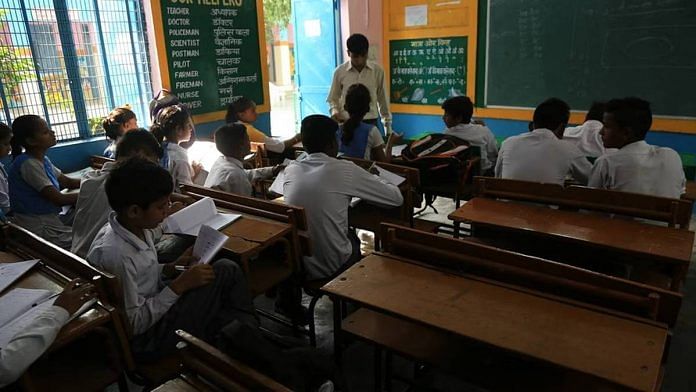New Delhi: With an aim to increase awareness about the works of Indian mathematicians in school students, the National Curriculum Framework 2023 seeks to both redesign the mathematics curriculum taught in schools here, as well as change the method of teaching the subject, shows a perusal of the framework document which was handed over to Union Education Minister Dharmendra Pradhan last month. The contents of the document were made public on 23 August.
According to the NEF document, the maths syllabus at the school level would include discoveries in foundational mathematics made in India and the “fascinating stories” behind them. ThePrint has a copy of the document.
From terms used for numbers like 10-to-the-power-10 and 10-to-the-power-12 in the Yajurveda — one of the ancient Indian scriptures — to the concept of Baudhayana (or Pythagoras) theorem, the development of the Indian system of writing numbers using the 0-9 digits (first used in the ancient India mathematical text, the Bakshali manuscript, according to the NCF document), and the trigonometric concept of sine (jya in ancient Indian usage) and cos (kotijya) in Aryabhata’s astronomical treatise, Aryabhatiya, the NEF seeks to look back at traditional Indian research in mathematics.
It also cites old Indian texts to claim credit for the finding of concepts like the infinite value of Pi in India by 14th-century Indian mathematician Madhava of Sangamagrama and for the theory of Fibonacci series being known to Indian mathematician Virahanka in the 7th century.
The new curriculum aims to trace the timeline of Indian contribution to the field of mathematics — from before the second millennium BCE to the discovery of a polynomial time algorithm to establish whether a given number is prime or not by IIT Kanpur professor Manindra Agarwal and his students Neeraj Kayal and Nitin Saxena in 2002
While the NCF — developed by a steering committee headed by former Indian Space Research Organisation (ISRO) chairman K. Kasturirangan, to overhaul school syllabi across the country — in general seeks to integrate Indian culture and knowledge with the education system, shows ThePrint’s reading of the document, special emphasis has been laid on maths to create awareness of “the extremely rich history in India”. The NCF document embodies the vision of the New Education Policy, 2020.
“Mathematics has an extremely rich history in India, spanning thousands of years from Vedic times to the modern era. By learning about the development of Mathematics in India as well as throughout the world, a rootedness in India can be enhanced along with a more general appreciation of the history of Mathematics and of the remarkable evolution and development of mathematical concepts through time, and India’s critical role in these developments,” states the NCF document.
The study of India’s mathematical history is suggested to be divided across chapters and grades across the “foundational\preparatory, middle and secondary levels” of the education system.
Further, to overcome a commonly perceived fear of the subject among students, the NCF document encourages teachers to adopt multiple learning and assessment methods to encourage conceptual understanding of the subject.
Also read: Biannual board exams, focus on practicals — National Curriculum Framework for school education
Graded introduction to work of Indian mathematicians
At the preparatory stage, students will be introduced to the “origin of Indian numerals” and the “decimal numeral system in use the world over”, states the NCF document.
Students at the middle and secondary stages will be taught about the development of important mathematical ideas and about the contributions of Indian mathematicians like as Baudhayana, Panini, Pingala, Aryabhata, Bhaskara I, Brahmagupta, Virahanka, Sridhara, Bhaskara II, Madhava, Narayana Pandita, and Ramanujan.
At the secondary stage, students will also learn about the contribution of Indian mathematicians to advanced mathematical ideas, including in the fields of algebra, coordinate geometry, combinatorics, and calculus.
The framework also calls for integration of mathematical approach with other subjects like arts, sciences and sports to make learning more practical and engaging for students.
Deliberating on the commonly perceived fear of mathematics among students and parental pressure to pursue science in higher studies, the NCF document states, “Similarly, mathematical ability is seen as central to ‘cracking’ competitive entrance exams for professional courses, such as those in engineering. Due to immense competition in these exams, parents sometimes end up burdening their children with immense pressure to go to coaching classes and get a high score in Mathematics.”
It encourages teachers and students to view math as “a subject of exploration, discovery, and creativity rather than a set of mechanical procedures.”.
It also encourages teachers to include puzzles and problem-solving tasks in the foundational grades to build spatial understanding and problem-solving mindset among students.
And calls for assessment based on understanding of concepts and mathematical skills and capacities, such as procedural fluency, computational thinking, problem-solving, visualisation, optimisation, representation, and communication. The NCF also gives provisions for open-book assessments that can go a long way toward reducing anxiety in students.
It reads, “Examinations could provide ‘fact sheets’ consisting of information, such as formulae, and definitions, so that students need not memorise them but use them in actual problem solving.”
(Edited by Poulomi Banerjee)
Also read: More ‘choice’, but also more exams — what National Curriculum Framework has in store for grades 9-12



